A powerful graphics card is likely the most expensive component in your PC if you're a gamer, but with all current and past-gen GPUs available in the range of $100 to $500, it can be tough to pick the right solution for your needs.
In an effort to narrow things down, we're about to compare today's most relevant gaming cards that sell for $200 or more, testing them in a slew of games to see how it breaks down as we look for the best graphics cards for gaming at resolutions of 1920x1200 and 2560x1600.
Most GPU releases go through our testbench, however when we review these graphics cards, the GPUs are fairly new or barely making it to market, drivers are not entirely optimized, and most importantly, true market pricing has not settled down to its long-term value.
| Models | Launch | Codename | Fab | Bandwidth | Release Price | Current Price |
| GeForce GTX 670 | 10-May-12 | GK104 | 28nm | 192.2 GB/s | $400 | $400 |
| GeForce GTX 680 | 22-Mar-12 | GK104 | 28nm | 192.2 GB/s | $500 | $500 |
| Radeon HD 7870 | 19-Mar-12 | Pitcairn XT | 28nm | 153.6 GB/s | $350 | $310 |
| Radeon HD 7850 | 19-Mar-12 | Pitcairn Pro | 28nm | 153.6 GB/s | $250 | $250 |
| Radeon HD 7950 | 31-Jan-12 | Tahiti Pro | 28nm | 240.0 GB/s | $450 | $350 |
| Radeon HD 7970 | 9-Jan-12 | Tahiti XT | 28nm | 264.0 GB/s | $550 | $450 |
| GeForce GTX 560 Ti | 25-Jan-11 | GF114 | 40nm | 128.2 GB/s | $250 | $230 |
| Radeon HD 6870 | 22-Oct-10 | Barts XT | 40nm | 134.4 GB/s | $240 | $180 |
Relative performance leads more often than not remain the same through the life of the GPUs, but our take on best value is completely changed the second Nvidia or AMD decide to adjust their prices. To give you a clear example, the Radeon HD 7970 debuted to market last January with a sticker price of $550. A couple of months later the GeForce GTX 680 arrived offering better performance for less money. AMD quickly reacted slashing the HD 7970's price to $450. Similarly, the slightly slower HD 7950 was dropped from its original price of $450 to just $350.
The table above includes all the cards we'll be benchmarking, starting with the most recently released. Note that although we have the Radeon HD 7970 GHz Edition on hand, we didn't include it in this review because we don't see why anyone would buy the factory overclocked solution at a $50 premium.
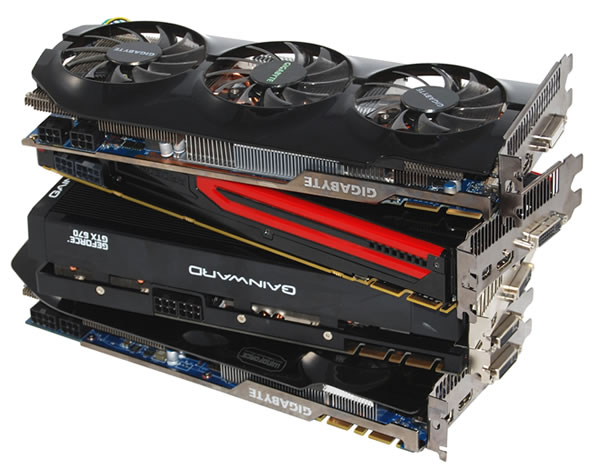
Testing Methodology
We picked ten games for our test, six of which are DX11 titles and include recent releases such as Max Payne 3 and Alan Wake. Games will be run at 1920x1200 and 2560x1600 as we believe these are the resolutions gamers are targeting with today's $200+ graphics cards, using monitors between 24 and 30 inches. All games will be tested with fraps which lets us record 60 seconds of gameplay.
Test System Specs
1920x1200 Performance
Performance: Radeon HD 7950
Value: Radeon HD 7870
For an average of at least 60fps or better when playing Metro 2033 at 1920x1200, the Radeon HD 7950 is your best choice with 68fps. That said, the HD 7870 offers a better value and delivers totally playable performance at 56fps. The GTX 670 also performed well, but because it costs more and performs slightly worse than the HD 7950, it's not the best option here.
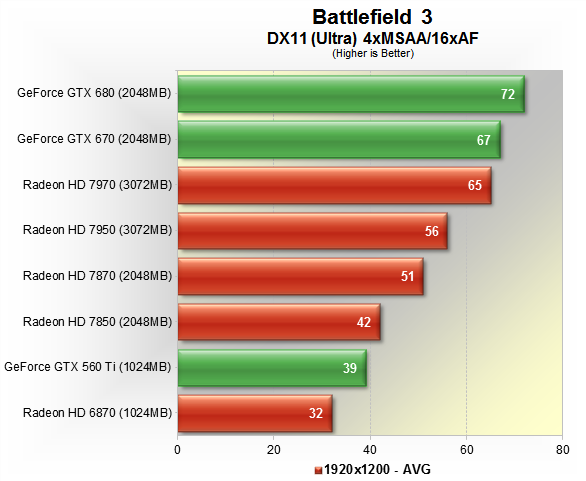
Performance: GeForce GTX 670
Value: Radeon HD 7950 or 7870
The GTX 670 managed to outpace the HD 7950 and HD 7970 by 11fps and 2fps, making it an easy pick for the best overall pick. However, HD 7950 remains a viable value-minded solution with 56fps, as does the HD 7870, which was only 9fps below the 60fps threshold.
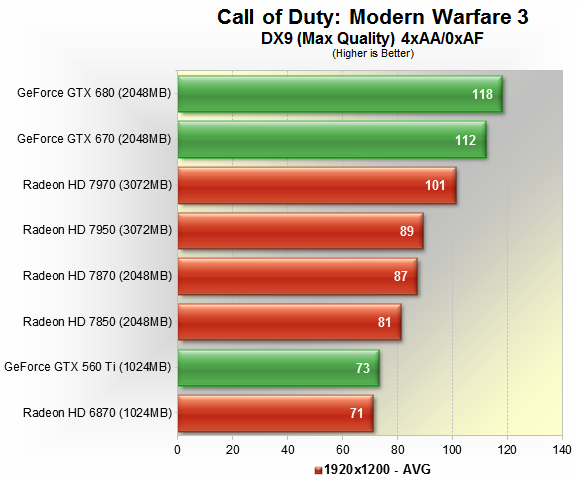
Performance: Radeon HD 7850
Value: Radeon HD 6870
Call of Duty: Modern Warfare 3 -- as you likely know -- isn't particularly demanding, making the GTX 670 and HD 7000 series overkill. At 1920x1200, the HD 6870 is more than capable of delivering a smooth experience at 71fps, as is the GTX 560 Ti at 73fps.
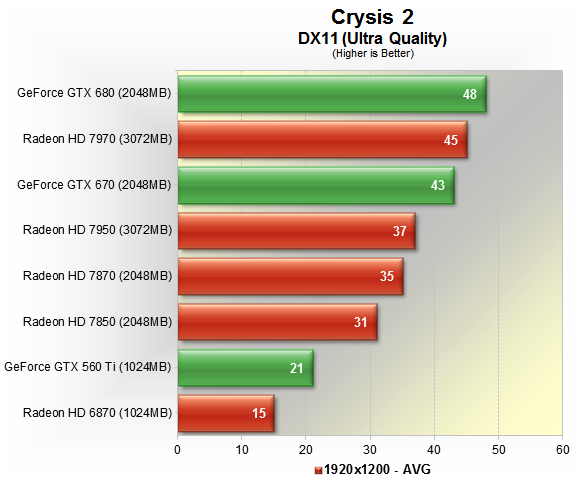
Performance: GeForce GTX 680
Value: GeForce GTX 670
Crysis 2 is extremely demanding with the high-resolution texture pack and the DX11 patch, so you'll want to hit it with all the force your wallet can muster, making the GTX 680 and 670 the best performance and value-oriented picks.
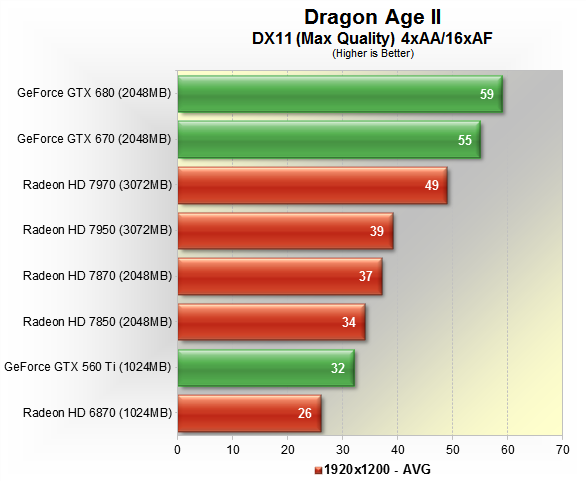
Performance: GeForce GTX 670
Value: GeForce GTX 670
Dragon Age II requires the GTX 680 if you intend to approach or exceed 60fps, though the cheaper GTX 670 is only a tad slower at 55fps and seems like the logical pick for both performance and value.
1920x1200 Performance, Part 2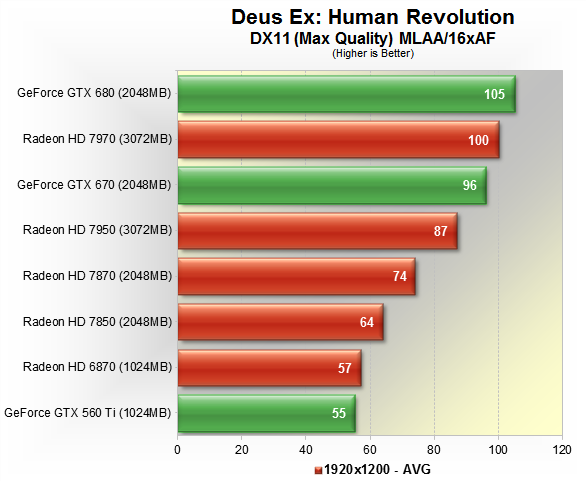
Performance: Radeon HD 7950
Value: Radeon HD 7850
Despite looking great, Deus Ex: Human Revolution isn't all that demanding on current-gen cards -- in fact, even the older HD 6870 and GX 560 Ti perform well. The best value at 1920x1200 is the HD 7850, while the best performance-oriented card is the HD 7950 at 87fps.
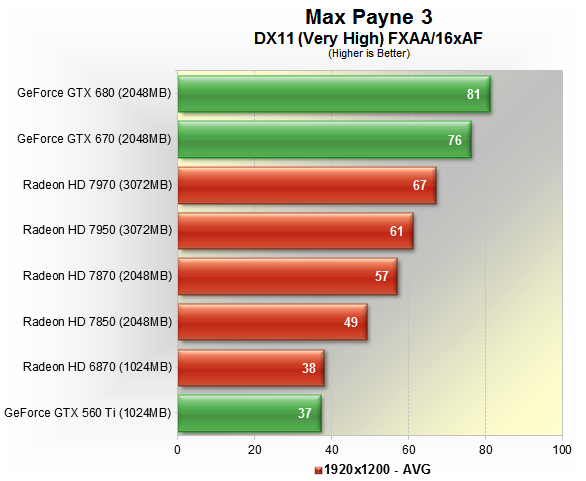
Performance: GeForce GTX 670
Value: Radeon HD 7950
Max Payne 3 plays exceptionally well on the new GTX 600 series cards and we believe that the GTX 670 is the best choice if you're looking for high performance, while the HD 7950 is the best value at 61fps, or only 6fps behind the pricier HD 7970.
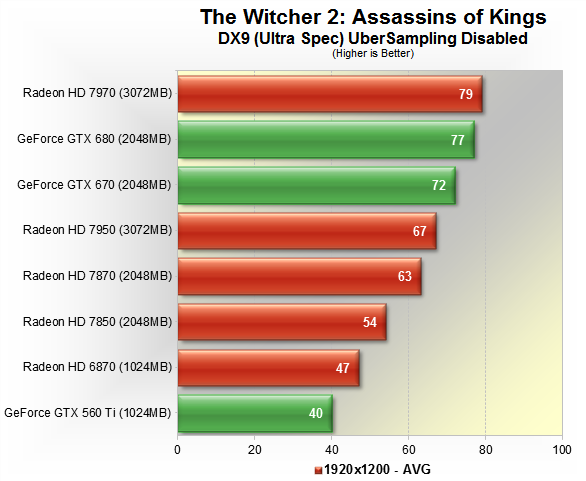
Performance: GeForce GTX 670
Value: Radeon HD 7950
Although it doesn't look (or perform) like it, The Witcher 2 uses DX9, which we found hard to believe when first testing this game. The game is pretty demanding at 1920x1200, though the GTX 670 managed to deliver 72fps, securing our performance-oriented pick, while the HD 7950 was only 5fps slower at 67fps, making it our value pick.

Performance: GeForce GTX 670
Value: Radeon HD 7870
While it is also a DX9 title, Skyrim isn't as demanding as The Witcher 2, so the GTX 670 can be considered somewhat overkill at 86fps, but it's still our top pick for a performance solution, while the HD 7870 is our value choice as it was on par with the more expensive HD 7950 at 63fps.
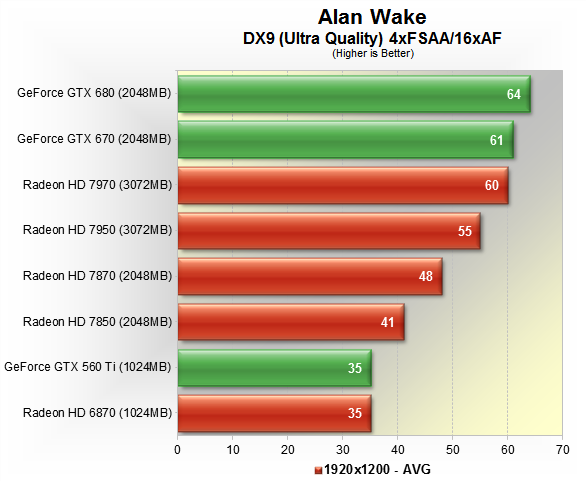
Performance: GeForce GTX 670
Value: Radeon HD 7950
The GTX 670 is a clear winner when testing Alan Wake at 1920x1200, averaging 61fps, slightly faster than the HD 7970 and just a fraction slower than the GTX 680. The best value option here is the HD 7950, which was just 10% slower than the GTX 670 while costing around 15% less.
Winners and Losers
Ever since we tested the GeForce GTX 670, we knew this had to be the best value high-end graphics card in the market. However, this impression was mostly based on 2560x1600 performance since the GPU could easily maneuver the workload. This time we are also looking at lower resolutions where other more affordable contenders can perform admirably (60fps or higher), so we were interested to see how it compared at 1920x1200.
We still feel the GTX 670 is the best performance option available at 1920x1200, but with an average of 71fps across the games tested, some might argue it's more than you need for the money. Therefore, staying true to our original parameters, the best value card for 60fps gameplay is the Radeon HD 7950.
Our data tables below will help you digest how today's graphics cards stack up. These findings are based on maximum visual settings for each title and the numbers will change drastically if you tweak visuals. By reducing or disabling certain features such as shadows, it is entirely possible to squeeze playable performance out of lesser cards at the tested resolutions. Given the endless possibilities, we're sticking with maximum settings for ease of making comparisons.
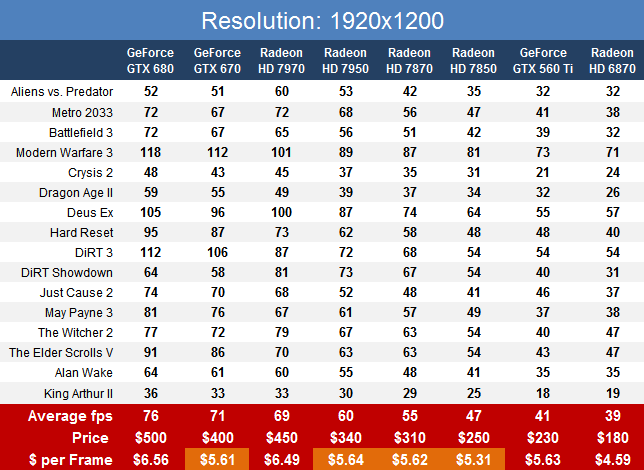
The GTX 670 is an incredible value for a high-end graphics card, costing $5.61 per frame with solid performance across the board. By comparison, you would pay $6.56 per frame with the GTX 680 or $6.49 per frame with theHD 7970. A strong case could also be made for the HD 7950, which runs $5.64 per frame but costs about $60 less than the GTX 670 and delivers an average performance of 60fps.
Similarly, it'd also be possible to get away with the HD 7870 at this resolution as it offered the same cost per frame value as the GTX 670, albeit with an average frame rate of 55fps and a total cost of $310.
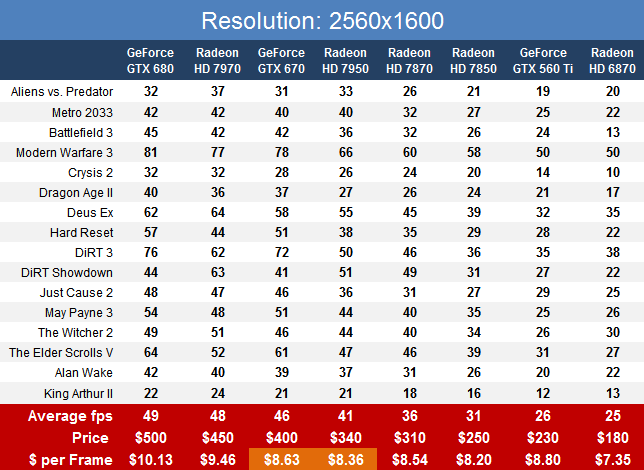
At 2560x1600, we picked the GTX 670 as both the best performance and value option, costing $8.63 per frame versus $10.13 for the GTX 680 and $9.46 for the HD 7970, while averaging only a few frames per second less.
The HD 7950 is technically a slightly better value than the GTX 670, but at extreme resolutions such as this, every frame counts and it's easy to justify a slight premium for Nvidia's card.
To recap, the GTX 670 is hands down the best pound for pound gaming card currently available. Although it's a tad overkill in some games today, one could argue you'll appreciate this leeway a year or two down the road. If you're running at ~1080p and you want to save a few bucks, you can opt for the Radeon HD 7950 or HD 7870and still achieve a frame rate above the desired 60fps threshold with most modern games.
Extra download: You can download the tables above in Excel format. Remove some games or give more emphasis to those titles you are most interested in, and calculate your own dollars per fps score. If graphics card pricing was to change in the near future you can also make the adjustments yourself and compare all cards head to head with ease.
|
|
No comments:
Post a Comment